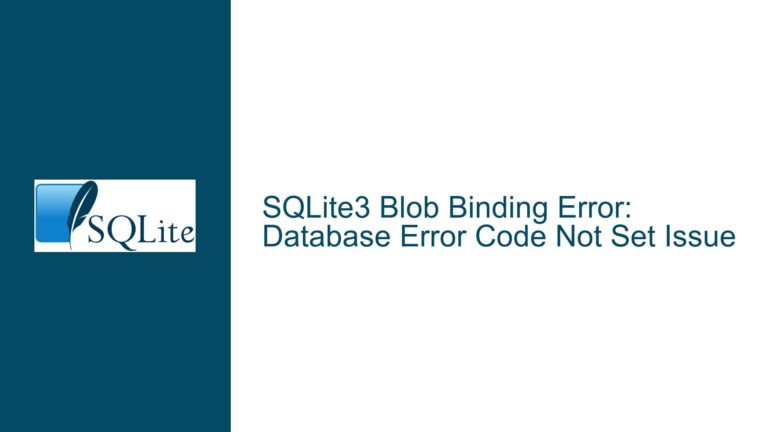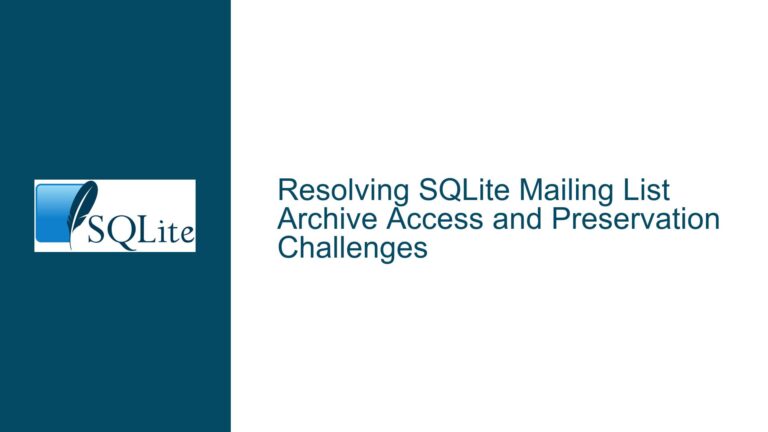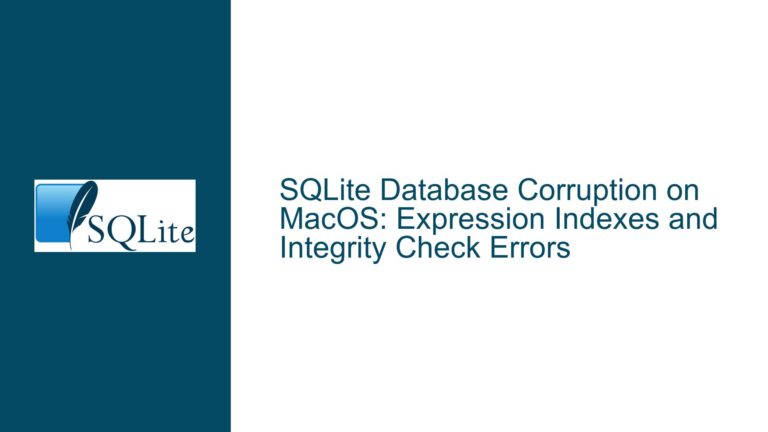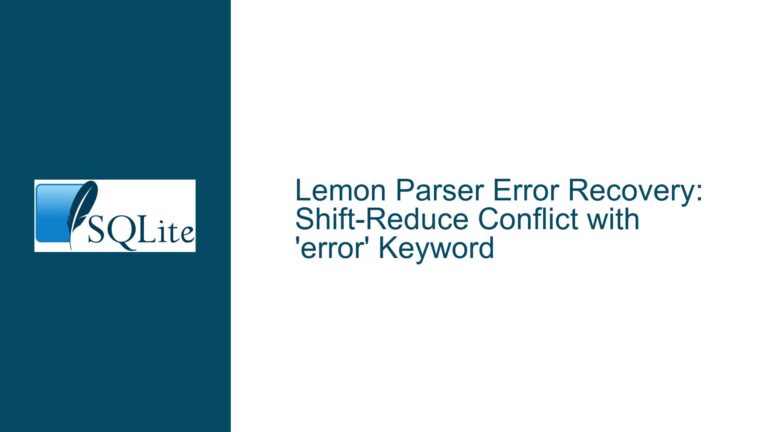Unexpected Query Results Due to UTF-16 Encoding Anomalies and Unordered Aggregation
Database Behavior with Invalid UTF-16 Text and Unordered Aggregates
Issue Overview: Silent Data Corruption and Order-Dependent Query Results
The core problem revolves around SQLite’s handling of text data containing invalid UTF-16 sequences and the interaction of such data with aggregation functions like GROUP_CONCAT(). Two databases with identical schema definitions, integrity check results, and exported .dump outputs produce divergent query results when aggregating text fields containing improperly encoded values. This divergence persists even after VACUUM operations, indicating that the issue is rooted in low-level storage mechanics rather than transient artifacts.
Key Observations:
- Invalid UTF-16 Sequences: The databases store text values with invalid UTF-16 byte sequences, such as odd-length byte streams (e.g.,
x'21'cast asTEXT). These values bypass SQLite’s encoding validation checks because the database engine adopts a "best effort" approach to preserve input bytes without enforcing strict encoding rules. - Hidden Data Discrepancies: While
.dumpand.sha3sumcommands report identical outputs for both databases, direct inspection of raw database pages (via tools likeshowdb) reveals structural differences in stored text payloads. These discrepancies are not surfaced by standard diagnostic tools because they operate on the logical representation of data rather than the physical storage layer. - Order Sensitivity of
GROUP_CONCAT(): The querySELECT GROUP_CONCAT(c||x'00','') FROM t;returns different results for the two databases because the order of rows processed byGROUP_CONCAT()is not guaranteed in the absence of anORDER BYclause. SQLite’s storage engine may return rows in different orders after structural changes likeVACUUM, exacerbating the problem when combined with invalid text data.
Technical Nuances:
- UTF-16 Encoding Pitfalls: When a database is configured with
PRAGMA encoding='UTF-16';, SQLite expects text values to conform to valid UTF-16 encoding rules. However, it does not reject values with malformed byte sequences (e.g., incomplete surrogate pairs or odd-length buffers). Instead, these values are stored as-is, leading to silent data corruption when interpreted as text. - Tooling Limitations: The
.dumpcommand converts text values to UTF-8 during export, discarding byte-level irregularities in the original UTF-16 data. Similarly,.sha3sumcomputes hashes based on the logical content of text fields, not their raw byte representation, causing identical hashes for databases with different underlying data. - Integrity Check Blind Spots:
PRAGMA integrity_checkverifies structural consistency (e.g., B-tree integrity, page linkage) but does not validate text encoding correctness. This creates a false sense of data integrity when invalid text values are present.
Possible Causes: Encoding Leniency, Tooling Assumptions, and Query Ambiguity
The root causes of this issue stem from SQLite’s design philosophy favoring flexibility over strict enforcement, combined with user expectations shaped by other database systems.
UTF-16 Encoding Permissiveness
- Odd-Byte-Length Text: SQLite allows storage of text values with odd byte lengths in UTF-16 databases. For example, a 1-byte value like
x'21'cast asTEXTis stored as-is, even though UTF-16 requires code units to be 2 or 4 bytes long. This violates the Unicode standard but aligns with SQLite’s "garbage in, garbage out" (GIGO) philosophy. - Best-Effort Decoding: When reading invalid UTF-16 text, SQLite replaces malformed sequences with placeholder characters (e.g.,
U+FFFD) but does not modify the stored bytes. This leads to discrepancies between the raw stored data and its interpreted value.
- Odd-Byte-Length Text: SQLite allows storage of text values with odd byte lengths in UTF-16 databases. For example, a 1-byte value like
Ambiguous Query Semantics
- Unordered Aggregation: The
GROUP_CONCAT()function concatenates values in an unspecified order unless anORDER BYclause is explicitly provided. Storage engine optimizations (e.g., page defragmentation duringVACUUM) can alter the physical row order, causing the same query to produce different results across database instances. - Implicit Data Type Conversions: Mixing text and binary data (e.g.,
c||x'00') triggers implicit conversions that may discard or alter invalid UTF-16 bytes. For example, appending aBLOB(x'00') to aTEXTvalue forces SQLite to reinterpret the entire expression asBLOB, masking encoding errors.
- Unordered Aggregation: The
Diagnostic Tool Limitations
.dumpCommand Simplifications: The.dumpcommand serializes text values as UTF-8 strings, stripping away encoding irregularities. This makes it unsuitable for detecting low-level data corruption in UTF-16 databases..sha3sumCommand Logical Hashing: The.sha3sumcommand computes hashes based on the interpreted value of text fields, not their raw byte representation. Consequently, databases with different invalid UTF-16 sequences that decode to the same logical text (e.g., empty strings due to decoding errors) produce identical hashes.
Troubleshooting Steps, Solutions & Fixes: Validation, Tooling Adjustments, and Query Rigor
Step 1: Detect Invalid UTF-16 Text
- Inspect Raw Bytes: Use
HEX(CAST(c AS BLOB))to retrieve the exact byte sequence of suspicious text fields. This bypasses SQLite’s text decoding logic and reveals malformed UTF-16 sequences.SELECT rowid, HEX(CAST(c AS BLOB)) FROM t; - Leverage
PRAGMADirectives: WhilePRAGMA integrity_checkdoes not validate encoding, custom checks can be implemented:-- Check for odd-length UTF-16 text SELECT rowid FROM t WHERE LENGTH(c) % 2 != 0;
Step 2: Prevent Invalid Data Insertion
- Use
BLOBfor Binary Data: Store binary or irregular text data asBLOBto avoid unintended encoding transformations.CREATE TABLE t (c BLOB NOT NULL); INSERT INTO t VALUES(x'21'); -- No cast needed - Enforce UTF-16 Validity: Add check constraints to validate text length and content.
CREATE TABLE t ( c TEXT NOT NULL CHECK( LENGTH(c) % 2 = 0 AND -- Even byte length for UTF-16 c GLOB '*' || x'00' -- Example: Disallow embedded NULs ) );
Step 3: Ensure Deterministic Query Results
- Explicit Ordering in Aggregates: Always use
ORDER BYwithGROUP_CONCAT()to guarantee consistent row processing order.SELECT GROUP_CONCAT(c||x'00', '' ORDER BY rowid) FROM t; - Avoid Implicit Type Conversions: Use explicit
CAST()operations when combining text and binary data.SELECT GROUP_CONCAT(CAST(c AS BLOB)||x'00', '') FROM t;
Step 4: Enhance Diagnostic Tooling
- Custom Hashing with Raw Bytes: Compute hashes using raw
BLOBvalues instead of interpreted text.SELECT sha3(CAST(c AS BLOB)) FROM t;Note: Requires a user-defined
sha3()function or external script. - Low-Level Database Inspection: Use tools like
sqlite3_analyzeror custom scripts to dump raw database pages and compare byte-level differences.
Step 5: Advocate for SQLite Enhancements
- Feature Request: Encoding Validation Pragmas: Propose new pragmas like
PRAGMA validate_textto check text encoding compliance. .sha3sumEnhancement Request: Request a--rawoption for.sha3sumto hash rawBLOBvalues instead of decoded text.
Final Recommendations:
- Treat Text as Immutable: Never modify text fields after insertion if encoding validity is uncertain.
- Prefer UTF-8 for New Databases: UTF-8’s byte-oriented design reduces encoding ambiguity compared to UTF-16.
- Adopt Defensive Programming: Validate text encoding at the application layer before inserting data into SQLite.
By addressing encoding validity, query determinism, and tooling limitations, users can mitigate the risks of silent data corruption and unexpected query results in SQLite databases.






